This post may contain affiliate links. Please read our disclosure policy.
This tutorial is to show you how to make Chinese potato starch noodles from scratch with only 2 ingredients. The noodles are naturally gluten-free.

Chinese potato starch noodles are incredibly easy to make with only 2 ingredients. They are one of the popular noodles in the Chinese kitchen. The noodles are naturally gluten-free and have a chewy and bouncy texture.
Ingredients to make Chinese potato starch noodles from scratch
You only need two ingredients to make the noodles from scratch and it’s naturally gluten-free too.
1. Potato starch
I use potato starch (NOT potato flour) for this recipe. You will see some recipes using sweet potato starch, also known as di gua fen (地瓜粉). It works too but the texture is different and the amount of water also may differ slightly. I prefer the one made with potato starch
2. Water
You will need hot boiling water and room-temperature water for this recipe

Homemade Chinese Potato Starch Noodles (Gluten-Free Noodles)
Ingredients
Initial batter:
- 50 g potato starch
- 50 g water room temperature
To gelatize starch:
- 100 g hot boiling water
To add last:
- 50 g water plus more as needed
- 190 g potato starch
Instructions
Initial batter:
- Mix the 50 grams of potato starch with 50 grams of water. It's kinda difficult to stir at first, but it will happen. Use a whisk may work better too.
Gelatinize the starch:
- Bring about 120 grams of water to a boil to account for some evaporation during boiling. Bring it to a rolling boil. I can't stress enough the importance of the water to be really at a boiling point. Once it comes to a boil, let it boil for another minute. If you have an instant-read thermometer, it should be at least 212 F (100 C)
- Then pour this really hot boiling water into the potato starch solution you prepared earlier. You will instantly see some gelatinization when the hot boiling water comes into contact with the starch. Whisk to combine thoroughly to form a gelatinous mixture.
Final mixing:
- Add the rest of 50 grams of water and the rest of the 190 grams of potato starch and whisk to combine. You will get a thick gooey paste consistency. I had to add an additional 30 grams of water to get the consistency I mentioned earlier. When you lift the batter up with a spatula, it will flow down slowly and steadily and you can see the trail doesn't disappear immediately. The consistency shouldn't be too thick that you can't pipe the batter in one continuous motion, but not too runny that the noodles will disintegrate when you boil it
Cook the noodles:
- It's not recommended to pour all the batter into a piping bag. It's harder to pipe and messier. Transfer 1/2 of the batter into a very sturdy large piping bag or double bag a plastic bag and snip off the tip to create a hole about probably 5 mm in diameter to get thick noodles that are suitable for stir-frying. If you want thinner, about 3 mm, this is not so suitable for stir-frying, more for soup or for tossing in sauce. If you use a small piping bag, transfer only 1/3 of the batter. Cover the rest of the batter in a bowl with a cling wrap while you cook the first batch
- Bring a large bowl of cold water near you. This is to stop the cooking process and also to prevent them from sticking to each other
- When the water is boiling, lower the heat to medium so it's just steadily simmering and start piping the batter in one continuous circular motion. You don't want the water to boil vigorously as it may break the noodles. Cook for about 30 seconds or until it floats.
- Then transfer to a bowl of cold water and let them sit in there while you are cooking the second batch. Transfer the next 1/3 of the batter and continue with the same process
- When you are done cooking all the noodles, discard the soaking water and transfer the noodles to a colander and gently rinse the noodles with some cold running water to get rid of excess starch
- The noodles may not seem as translucent when you just made them. When you cook them again in other recipes they will turn more translucent
- You can use the noodles to make this suan la fen or for stir fry like this Korean japchae
How to store: (UPDATED)
- If you don't use the noodles immediately, toss them in a bit of oil to prevent sticking. They can be stored in the fridge for about 3 days. I don't recommend any longer as the texture can get mushy
- You can't freeze the noodles as it changes the texture. So don't make a big batch
RECOMMEDED TOOLS
*Nutrition facts are just estimates and calculated using online tools*

How to make Chinese potato/sweet potato noodles from scratch
1. Bring a large pot of water to a boil. Mix the 50 grams of potato starch with 50 grams of water. It’s kinda difficult to stir at first, but it will happen. Use a whisk may work better too.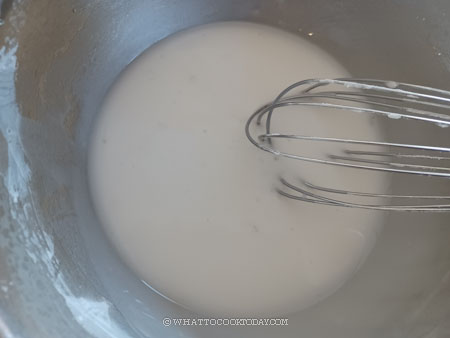
2. Bring about 120 grams of water to a boil to account for some evaporation during boiling. Bring it to a rolling boil. I can’t stress enough the importance of the water to be really at a boiling point. Once it comes to a boil, let it boil for another minute
3. Then pour this really hot boiling water into the potato starch solution you prepared earlier. You will instantly see some gelatinization when the hot boiling water comes into contact with the starch. Whisk to combine thoroughly to form a gelatinous mixture.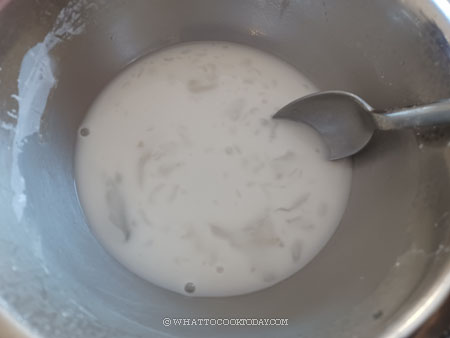
4. Add in the rest of 50 grams of water and the rest of the 190 grams of potato starch and whisk to combine. 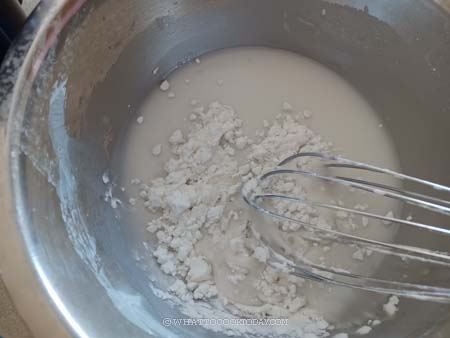
5. You will get a thick gooey paste consistency. When you lift the batter up with a spatula, it will flow down slowly and steadily and you can see the trail doesn’t disappear immediately. The consistency shouldn’t be too thick that you can’t pipe the batter in one continuous motion, but not too runny that the noodles will disintegrate when you boil it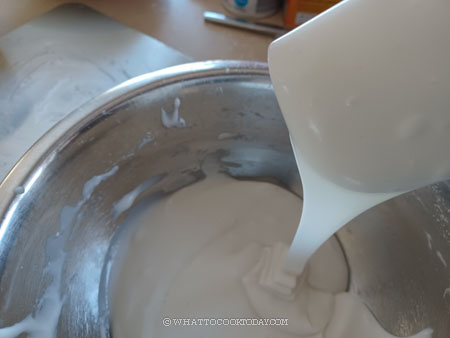
5. It’s not recommended to pour all the batter into a piping bag. It’s harder to pipe and messier. Transfer 1/2 of the batter into a very sturdy large piping bag or double bag a plastic bag and snip off the tip to create a hole about probably 5 mm in diameter to get thick noodles that are suitable for stir-frying. If you want thinner, about 3 mm. If you use a small piping bag, transfer only 1/3 of the batter. Cover the rest of the batter in a bowl with a cling wrap while you cook the first batch
6. When the water is boiling, lower the heat to medium so it’s just steadily simmering and start piping the batter in one continuous circular motion. You don’t want the water to boil vigorously as it may break the noodles. Cook for about 30 seconds or until it floats.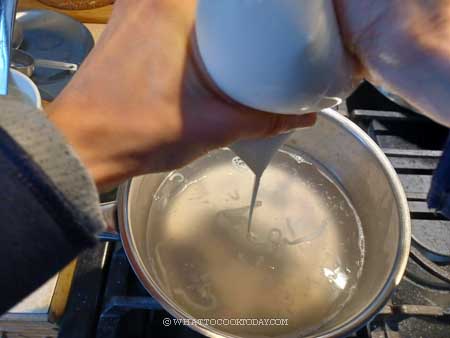
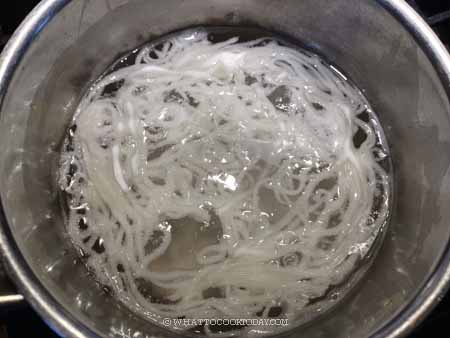
7. Then transfer to a bowl of cold water and let them sit in there while you are cooking the second batch. and continue with the same process

8. When you are done cooking all the noodles, discard the soaking water and transfer the noodles to a colander and gently rinse the noodles with some cold running water to get rid of excess starch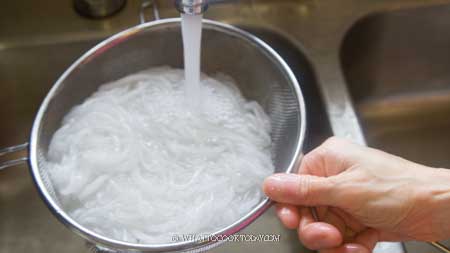
9. If you don’t use the noodles immediately, toss them in oil to prevent sticking. They can be stored in the fridge for about 3 days. I don’t recommend any longer as the texture can get mushy I don’t recommend any longer than that as the texture changes
What to use potato starch noodles for
They can be used for noodle soups such as suan la fen tang, stir-fry such as this Korean japchae, noodle salad such as this Din Tai Fung seaweed beancurd salad, or just tossed with sauce of your choice.
How to store cooked potato starch noodles
If you don’t use the noodles immediately, keep them soaking in fresh water until you are ready to use them. If they stick to each other, rinse with some fresh water and they will loosen up. It is best to use the noodles on the same day, but if you do have leftovers, transfer them to an air-tight container and soaked in water. Keep them in the fridge for 1-2 days in the fridge. I don’t recommend any longer than that as the texture changes
Did you make this potato starch noodles recipe?
I love it when you guys snap a photo and tag to show me what you’ve made 🙂 Simply tag me @WhatToCookToday #WhatToCookToday on Instagram and I’ll be sure to stop by and take a peek for real!
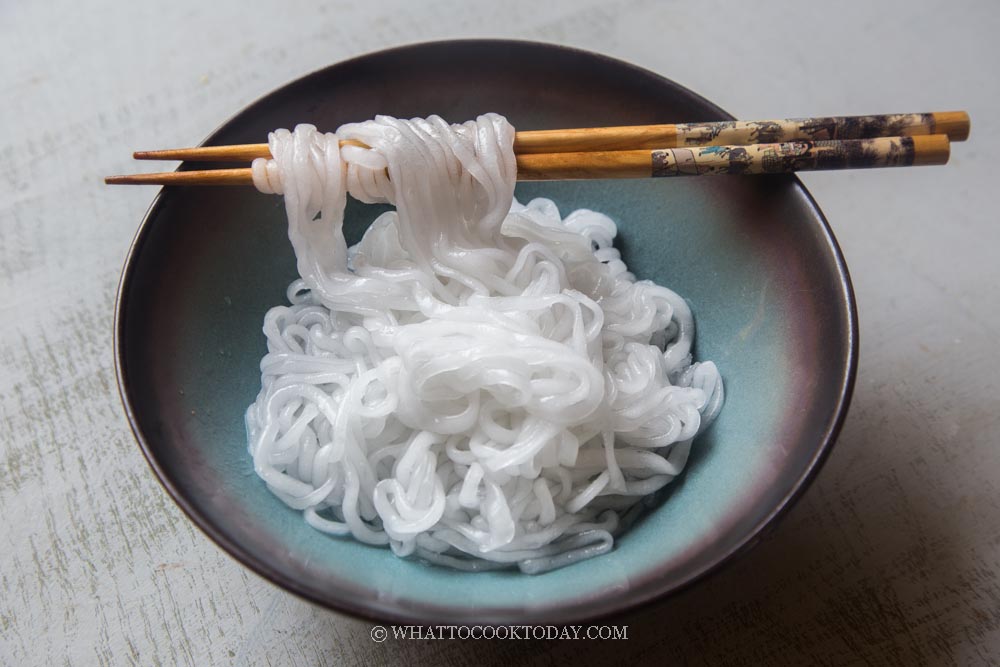

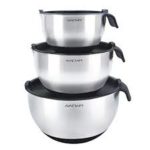

8 comments
Is it best to use thick or thin sweet potato starch for making noodles?
Hi Rita, I’m not sure if I understand your question. I only know one kind of sweet potato starch.
Excited to try this! Can I use mung bean starch instead of potato starch in this recipe?
Hi Ivy! I’m not sure if it will work with mung bean starch. I use mung bean starch to make this liang fen before https://whattocooktoday.com/liang-fen.html but never tried it to make this though, so I can’t tell you for sure if the substitution will work! sorry :/
THESE ARE AMAZING! I made them and they came out ok, but some parts of the noodles were still white. What do you think I did wrong?
Hi Sally, I wonder if they just need a slightly longer cooking time. Did you use potato starch or corn starch to make the noodles ?
It was potato starch, ok I will try it again today with longer cooking time! Wish me luck!
I hope it turned out better for you this time! Let me know when you have the chance 🙂